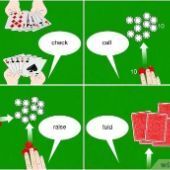Should You Play 5-Card Draw or Texas Hold’em?

Any debate involving Texas hold’em vs. 5 card draw has to begin with a look at the two games, what makes them similar, and the differences between them.
You can find plenty of opportunities to try both games at any of the best online poker sites. Still, it’s a good idea to make sure you understand the fundamental similarities and the definite differences between the two—and calls for a review of the basics.
In some cases, conditions in five-card draw may seem similar to those of Texas hold’em, but those similarities can be deceptive. And failure to understand the differences can result in a disappointing experience, whichever game you’re playing.
So, let’s begin the 5 card draw vs. Texas hold’em debate with the basic flow of each game.
The Fundamentals of 5-Card Draw

Any 5-card draw and Texas hold’em comparison need first to mention that five-card draw is the granddaddy of all other poker games, including hold’em, Omaha, razz, ad infinitum.
Now that that’s out of the way, there are regular and low-ball versions of five-card draw—and even variants where the players draw more than once—the game typically played around card tables in rec rooms and dining rooms around the world is one deal, a round of betting, discard and draw cards, another betting round, then a showdown.
Five-card draw is probably how you learned to play poker. It’s simple enough that children can learn it and yet rewarding enough at the real money level that adults have built careers around it.
It also serves as an excellent way to learn the hierarchy of hands—even that confusing one where everybody has their own opinion of whether a straight beats a flush or vice versa.
This is typically not a problem in home games, where finding enough players to make the game fun is a constant challenge, but in casino and card room play, five-card draw is generally limited to six or seven players.
The game begins when all players ante (put a small amount of money into the pot). Once that is accomplished, the dealer deals one card each clockwise around the table, beginning with the player to their immediate left. Each player receives five cards.
Once the first five cards have been dealt to all players, the wagering begins. In five-card variants like jacks or better, the wagering may only be opened by a player possessing at least a pair of jacks. In a regular game of five-card draw, however, anyone can open the wagering.
The opportunity to open the wagering during the first round rotates, as did the deal itself.
The first bet opens the wagering session. Each player is given the choice of folding, calling (matching the bet), or raising. The number of raises (called “bumps”) is often limited to two or three separate raises.
Once all players have made their choices, the draw begins, starting with the first player to the left of the dealer that is still in hand. Each player discards however many cards they wish to replace with new cards, and the draw proceeds until all remaining players receive their request.
A second round of wagering begins, traditionally started by the player who opened the first round of betting. All the remaining players have another opportunity to fold, call, or raise until all the pot is right.
At that point, either a showdown between the remaining players occurs, with the player with the best hand winning the pot; alternatively, the pot is raked by the sole survivor of the second betting round.
For more information and solid strategy tips, check out our guide to five card draw.
Texas Hold’em Essentials
Texas hold’em is a variant of five-card draw poker, and while it restricts the number of cards in play, it expands the number of wagering opportunities for each hand.
The ultimate goal is the same as that of five-card draw: To achieve the highest-ranked five-card hand at the table.

Unlike five-card draw, only two players in Texas hold’em must ante each hand. Responsibility for this rotates around the table, just ahead of the dealer—a duty that also rotates around the table.
In poker rooms, the actual dealer remains stationary while a small plaque or disk labeled “dealer” is rotated to represent the player who is considered the dealer.
The player to the immediate left of the button makes the small blind (generally half the amount of the big blind), and the player to the immediate left of the small blind makes the big blind.
The name of the game tells you what is expected from the blind more: a $2/$5 NL hold’em game is a game in which the small blind is $2, the big blind is $5, and there is no limit (“NL”) to the amount that may be wagered during a single round of betting.
Those initial wagers are made before the dealing of any cards and are considered blind wagers.
Generally speaking, the ante makes five-card draw a slightly more expensive game of poker—at least in the initial stages of each hand—since all players must ante up before each hand is dealt. However, the blinds of hold’em are typically larger than a commensurate ante in a five-card game, so the difference appears to be a wash.
Still, the blinds are not inconsequential, and battles are fought over the blinds all the time. How often does that happen? Often enough for us to defend your big blind.

Once the blinds have been posted, the dealer deals each player at the table with two hold cards (often called pocket cards). Once all players have two pocket cards, the first round of wagering begins, starting with the player to the immediate left of the big blind—this position is called “under the gun” (UTG). The UTG player may fold, call by matching the big blind or raise by wagering twice the amount of the big blind.
The remaining players may—in turn—either match the largest bet before them, folding or raising. Once the first betting round is finished, the first three community cards are dealt. This is called the flop.
Another round of wagering occurs after the flop. Once this wagering round is completed, a fourth community card is dealt, called the turn.
Yet another round of wagering takes place, and as long as at least two players remain in hand at the end of his round, the final community card, called the river, is dealt.
A final round of wagering takes place, and –provided at least two players remain in the game—a showdown occurs wherein all active players reveal their pocket cards. The pot is awarded to whoever has the best five-card hand comprised of any five-card combination of pocket cards and community cards.
For more on the fundamentals and strategy, check out our Texas Hold’em Poker guide.
Similarities Between Texas Hold’em and 5-Card Draw
The biggest similarity between the five card draw vs. Texas hold’em is that they share an identical hand hierarchy, meaning that a hand that will win against any other hand will conform to the least likely winning hand to the most likely.
Here’s the order in both games, from worst winning hand to best.
You probably already know that the chances of being dealt or drawing a royal flush are just the tiniest bit longer than those of drawing a high card or a single pair.
In fact, your odds of being dealt a pair in five-card draw are slightly less than 50-50. In real life, three of the six people playing five-card draw at your table were probably dealt a pair (or better).
The same basic odds exist in Texas hold’em. You’ll flop a pair about 50% of the time (assuming you weren’t dealt a pocket pair). If the flop did not improve your hand, it likely improved your competition’s hand.
In both games, you can always chase a straight or a flush draw, but understand that while in five-card draw, you’ll be allowed to draw up to four new cards, in Texas hold’em, only two more cards will be dealt that can improve your hand.
What Makes the Two Casino Games Intrinsically Different?
The use of community cards and the number of wagering rounds are usually the most significant differences cited by experts when asked to explain Texas hold’em vs. 5 card draw. Let’s take a closer look.
Number of Players
Generally speaking, you’ll find no more than seven players at a five-card draw table. In-home games, this is more a feature than a bug since most homes don’t have tables that can accommodate many players comfortably.
On the other hand, nine and ten-player tables are more the rule than the exception in Texas hold’em. Yes, there are six-player maximum tables, which improves the game’s speed and increases the participation in each hand.
Ante vs. Blinds
The blinds of hold’em allow players to see more hands than they would in a five-card draw game, which has the added benefit of encouraging bigger pots (more players=larger pots)
Betting Rounds
The two primary betting rounds of five-card draw tend to limit the size of the pots, making it a good choice for home games since winning money is only one of the many reasons for playing the game.
The social nature of five-card draw—particularly at the rec room/garage level—cannot be emphasized enough. Socialization is virtually nonexistent at the hold’em table, however.
Opportunities to Read Opponents
While you can “read” your opponents anytime in either game, it is wagering where we tend to discover the most useful information about our opponents’ strengths. Sure, they could be bluffing, but is it worth an all-in to find out?
With its two betting sessions per hand, a five-card draw limits our ability to guesstimate what our opponents are holding. Texas hold’em, on the other hand, has double the wagering opportunities.
Availability Online
There was a time when five-card draw was the king of poker. Still, since the advent of the internet and the universality of online gaming, Texas hold’em has become the undisputed most popular gambling game on the planet.
But it wasn’t just the internet that made it happen. Texas hold’em wins any comparison with its greater number of wagering sessions and the fact that more people can play it at a single table—both of which build solid and healthy pots.
The Cost to Play
The flip side of that, of course, those four wagering sessions in a Texas hold’em hand make the game cost more to play. Of course, a good player learns quickly that sitting out more hands at the hold’em table is wiser.
The initial pre-draw betting may make chasing a straight or flush draw—or even setting a low pair—worthwhile in five-card draw. Such is not often the case with hold’em.
Texas hold’em makes chasing cards much more punishing.
There are plenty of reasons to take a break from the poker table, but to end a costly bout of chasing is among the most important.
Whatever your poker game, process, or mindset may be, you can always strive to get better. Consider adapting the following good poker habits to ensure you become the best player possible.
Which Casino Game Is Ultimately Better?

Many people don’t realize it, but all poker variants requiring a risk of something (matches, chips, acorns, or money) are games of attrition. The ultimate losers are those who attrite faster than their competition. It isn’t about whether you win or lose; it boils down to how little you lose compared to how much you win.
That is not a distinction without a difference. If you remain in the game longer, you will win more. If you fold when you do not have a chance of winning (considering the odds of what you have against what you think your opponents have), you will remain in the game longer.
By the power of simple logic, we will win if we remain in the game longer while losing less frequently.
If you want to drink beer with your buddies and share gossip and dirty stories while playing a friendly game of poker, go five-card draw all the way. Heck, throw in some wild cards, just for kicks. Walking away from the table having lost $7.35 during nine hours of play is, quite frankly, an astonishingly good entertainment investment.
On the other hand, if you want to win enough to keep you in silk cargo pants and Tommy Bahama shirts for the rest of your life aboard your yacht, then your best shot is Texas hold’em.
To help you decide—or to practice your working knowledge of both games, check out the action at one of our best US casinos online.
Good luck!
 80%
80% 75%
75%
